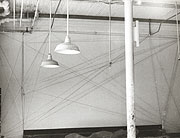Sol LeWitt
When Sol LeWitt made his first wall drawing in 1968, he began a rich, new dimension of his practice that challenged the notions of permanence and singularity that are so central to the Western valuation of art. His wall drawings, which are executed by assistants following a smaller drawing or set of rules he has devised, exist only in one place at any time. A collector purchases not the drawing itself, but the idea; if they loan it to an exhibition, their executed drawing is painted out. Likewise, when that exhibition closes, the drawing is painted over at the show before it is redone for the owner.
For “The Plain of Heaven,” LeWitt has created two wall drawings in a small room on the third floor of the building. The Location of a Circle, a Square and a Straight Line, a new work made specifically for the show, is directly across from Wall Drawing #51. One of his earlier drawings, #51 was first installed in Torino, Italy in 1970, and has never before been executed in the United States. It consists of blue chalk lines that are snapped between all the architectural points of the wall—a work that arises opportunistically across the skin of a ruin.
In a marked departure, LeWitt will leave these two drawings on the walls of the room after the close of the exhibition, until the building is either reoccupied or destroyed. In so doing, LeWitt recalls the installation that Barry Le Va did on the floor of the original 1927 building of the Walker Art Center in Minneapolis in 1969, designed to be destroyed when the building was torn down to make way for a new wing.
In his notes on wall drawings, LeWitt states that each “is a permanent installation, until destroyed.” He adds the admonition that “once something is done, it cannot be undone.” But located in this space between permanence and impermanence, his wall drawings can be re-done. By definition, they endure longer in the mind than on the wall.����������
����

Wall Drawing #51, All architectural points connected by straight lines, 1970������


